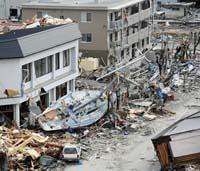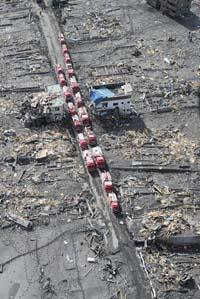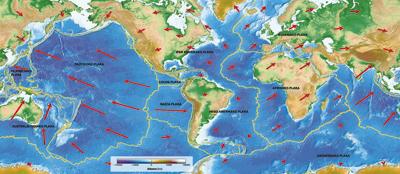What, yes, when, no

One of the major claims of seismologists is to predict when earthquakes will occur.
Just as when pushing a piece of dominoes fall all those next to it, the movement of the earth's crust that occurs by an earthquake moves the parts of the adjacent surface. Those who come behind are of magnitude less than the first earthquake and "can occur for several months until the entire territory is restabilized", explains Arturo Apraiz, professor of geology of the UPV and expert in tectonics.
In Lorca, for example, there have been 50 replicas after the main earthquake of magnitude 5.1. In Japan, for its part, only replicas of more than 5 magnitudes of the Ritcher scale accounted for more than five hundred, according to the local meteorology agency, until the end of April. Five of them were of more than 7 magnitudes and seventy-five of more than 6. All of them are considered replicas of the first.
Beyond its influence in the following parts of the earth's crust, during the annual assembly of the Seismological Association of the United States, in April, that is, immediately after Japan, it was discussed whether a series of great earthquakes have not been ignited lately. In fact, since 1900 only seven earthquakes have been greater than those of magnitude 8.8, of which three have occurred in the last six years: 2004 in Sumatra (Indonesia), 2010 in Chile and previous March in Japan.
Two researchers from the University of Texas and the U.S. Geology Service (USGS) hypothesized that by expanding the liberated energy into a large earthquake on the surface of the Earth, will no other major earthquakes occur in other parts of the world? They concluded that no. According to the journal Nature Geoscience, "the great earthquakes -- of magnitude 7 -- only have the capacity to produce earthquakes two thousand kilometers away. Specifically, the influence can reach a distance of two or three times the length of the land area destabilized by the first earthquake."
Arista del Pacífico, active zone
In any case, the Earth does not need to be in a time of great earthquakes so that large earthquakes occur in Indonesia, Chile and Japan. All these regions are by themselves a geologically very active territory. All of them are located on the shores of the Pacific Ocean, that is, in the so-called ring of fire. This is the name given by the fact that this round of the Pacific produces the largest volcanic and seismic activity on Earth.
On the entire shore of the Pacific Ocean, tectonic plates are approaching. On the one hand, the Pacific plate underlying most of the Pacific Ocean forms the subduction zones (intrusion), with plates from Australia-India, the Philippines, Eurasia and North America. Japan, in particular, is among the last three. At the western ends of the Pacific Ocean, for their part, the Cocos and Nazca plates form subduction zones with continental plates of oceanic edge, that is, plates of the Caribbean and South America.
In all cases, since one of the plates is suboceanic and the other is subcontinental, and the subcontinental ones are eight times thicker than the suboceanic ones, it is the oceanic ones that penetrate under the continental ones. It is a movement in which the plates rarely advance and a huge friction occurs in the edges. But by not interrupting the movement of the plates, the tension is accumulating. As with tightening an elastic rubber, the tension cannot be accumulated unlimited. And then, crak, fractures occur and, with it, an earthquake, since all the accumulated energy is instantly released.
"The time that can last until the energy is released and the amount of tension that can accumulate depends, among other factors, on the type of material that the crust has in the area and the number of failures that it has," explains Apraiz. That is, it depends on the stiffness of the body that breaks: in general, the more rigid and the less fractures there are in the body, the more tension accumulates and, therefore, more earthquakes. But the terrestrial surface is very heterogeneous, so it is difficult to know how many tensions it is able to accumulate".

In Japan, coinciding with the 9th magnitude earthquake, the tension accumulated for years and years caused the displacement of the island to the east of two and a half meters. This was announced by the ESA satellite Envisat. "As the energy has been released suddenly, everything has suddenly moved. It could happen that instead of an earthquake of 9th magnitude there were thousands of earthquakes of 6th magnitude, and then it would have also moved two and a half meters, but little by little," says Apraiz.
Prediction of earthquakes, statistical issue
Due to the continuous movement of tectonic plates, earthquakes can be expected to occur periodically in a given territory and the magnitude of these earthquakes does not vary too much. The predictions of earthquakes are made, in most cases, from historical data. In Japan, for example, such earthquakes were not expected to occur.
According to seismologist Hiroo Kanamo of the California Institute of Technology, "in recent centuries there have been earthquakes of approximately 8 magnitudes in this region. Never until 9". Considering that Ritcher is a logarithmic scale, going from 8 to 9 implies that the force of the earthquake is 30 times greater.
The Japanese sexism record was described by mathematician Baron Dairoku Kikuchi in the book Recent Seismological Investigations in Japan published in 1904. There he collected that there were 2,000 earthquakes recorded throughout the history of Japan and that the first was 416. However, he noted that the systematic observation of the earthquake began in 1875.
Taking a statistical approach, and taking into account the time elapsed since the last earthquake, scientists can know if the probability of an earthquake occurring in a given territory is high or low, and the approximate magnitude of the earthquake in question. But "it is impossible to predict when an earthquake will occur today," explains José Luis Granja, Professor of Geophysics at the Complutense University of Madrid.
Other methods of prediction in its beginnings
If periodic earthquakes occur, it is because tension accumulates until it can no longer be maintained during that time. Therefore, the measure of the tension that is accumulated in the rocks in areas with a tendency to earthquakes can be a more precise way of predicting earthquakes. And scientists have begun, "especially in Japan and the United States, which are the most developed countries that suffer the most earthquakes", said Apraiz.
However, very few regions have this type of meters. According to USGS, "in the United States, only in the San Andrés fault can be followed and predicted."
As explained on the USGS website, this system "allows us to know when the rocks reach the critical point due to the movement of the plates". However, despite reaching a critical point, Apraiz affirms that "the heterogeneity of the terrestrial surface and the factors that condition the appearance or not of earthquakes is so difficult to determine reliable scientific methods to predict the timing of the earthquake," he added. In the same line are the words of José Luis Granja: "Seismic cycles are not constant and there are many external parameters and variables that we cannot control or know. In fact, our knowledge of the interior of the Earth is quite limited."

According to Apraiz, "the only well-established mathematical model is the one that announces when and how much the violent replica will occur after a great earthquake. To do this, a thorough knowledge of the geology of the territory is also necessary."
Outside the methods mentioned, at some point it appears that the behavior of animals can predict earthquakes. Or to propose other methods of prediction. For example, in 2009, in L'aquila (Italy), before an earthquake of magnitude 6.3 occurred, a technician from the Gran Sasso National Laboratory, Giampaolo Giuliani, fired the alarm. It detected the fluctuations of noble radon gas through several radometers, which was later an epicenter in the area and announced that an earthquake would soon occur.
Despite the fact that the prognosis in this case was fulfilled, Granja considers that "it is an uncontrasted methodology and that it has not given definitive results, as they have been able to verify different groups of American, Japanese, Chinese, etc. To succeed by announcing with this type of methods does not give him credibility, they are only specific issues".
Predictions for prevention
If earthquakes were predictable with great precision, a perfect method would be obtained to avoid deaths. "There is a lot of interest and those who achieve a good prediction method would deserve the Nobel Prize," says Apraizek-. It is a field of first order research because it would save lives, foresee great destruction, etc. ".
However, with current methods, "the only thing that can be done is prevention," he acknowledged. They do so in countries like Japan, where they build their houses to stand up to earthquakes, protect the industry to the full, etc. In fact, Japan is, according to Granja, "the country best prepared before the earthquake. If the tsunami had not coincided with the earthquake, there would be little damage to infrastructure and very few people affected."
Therefore, "the predictions serve to take preventive measures and know that the earthquake will ever occur, but you can't make an evacuation plan; you can't leave an empty territory for years, waiting for the earthquake to occur," explains Apraiz.
At this time they are in California in the area of the San Andrés fault. The Big One is the name given by experts to the earthquake that is about to happen. Statistically it is time for the great earthquake to be repeated in 1906, which has historically occurred every one hundred years. However, according to Apraiz, "it can be now or within forty years. And we have a very short time record; if we had a record of earthquakes of the last 5,000 years, we could make more accurate approximations. In addition, on a geological scale, the interval of forty years is a gap. So, what is there to do in this situation? Depopulation San Francisco? Until when? What if there are no earthquakes? You already know it will be finally, but there are no deadlines and can spend years for when the announced is fulfilled."







